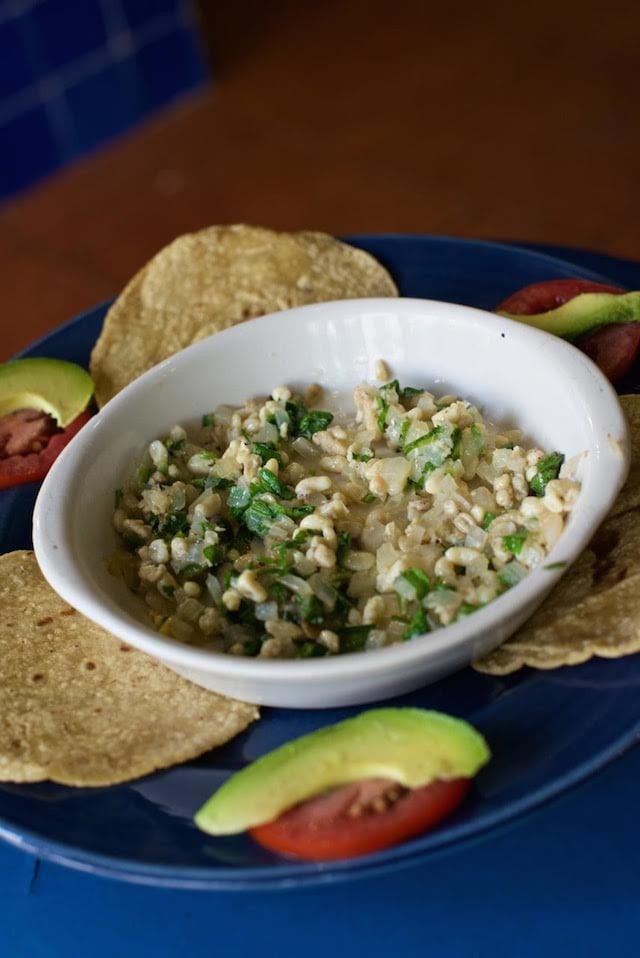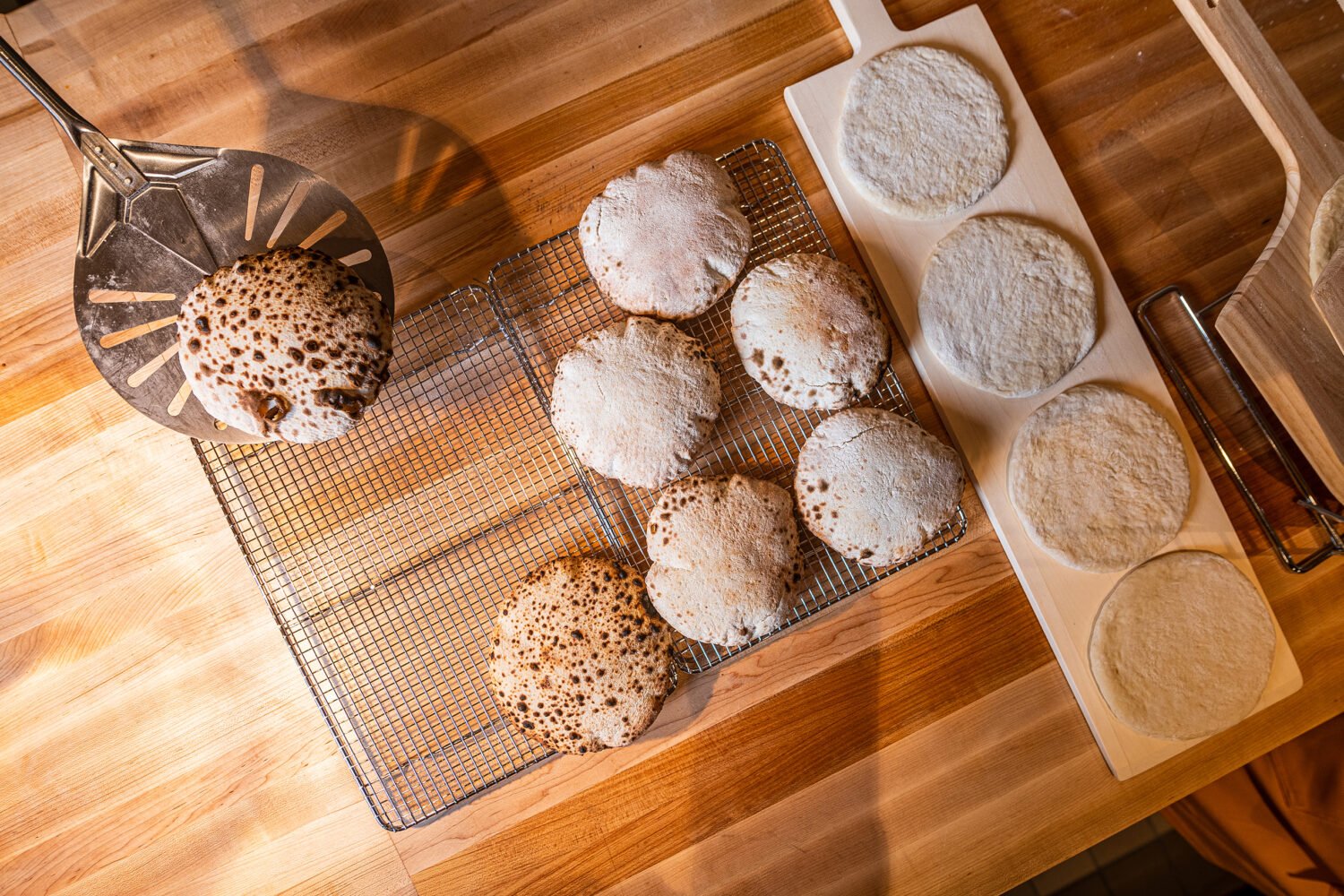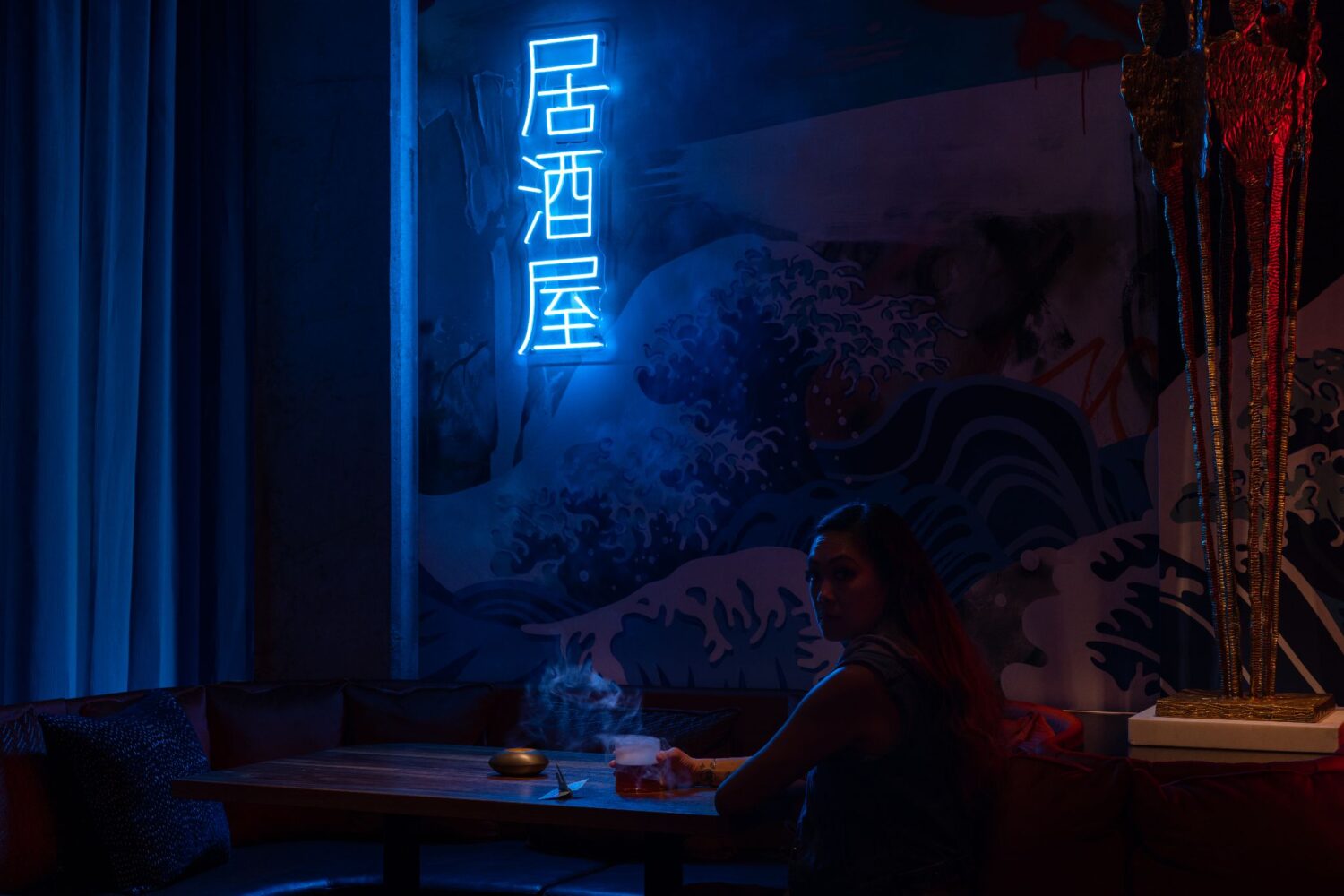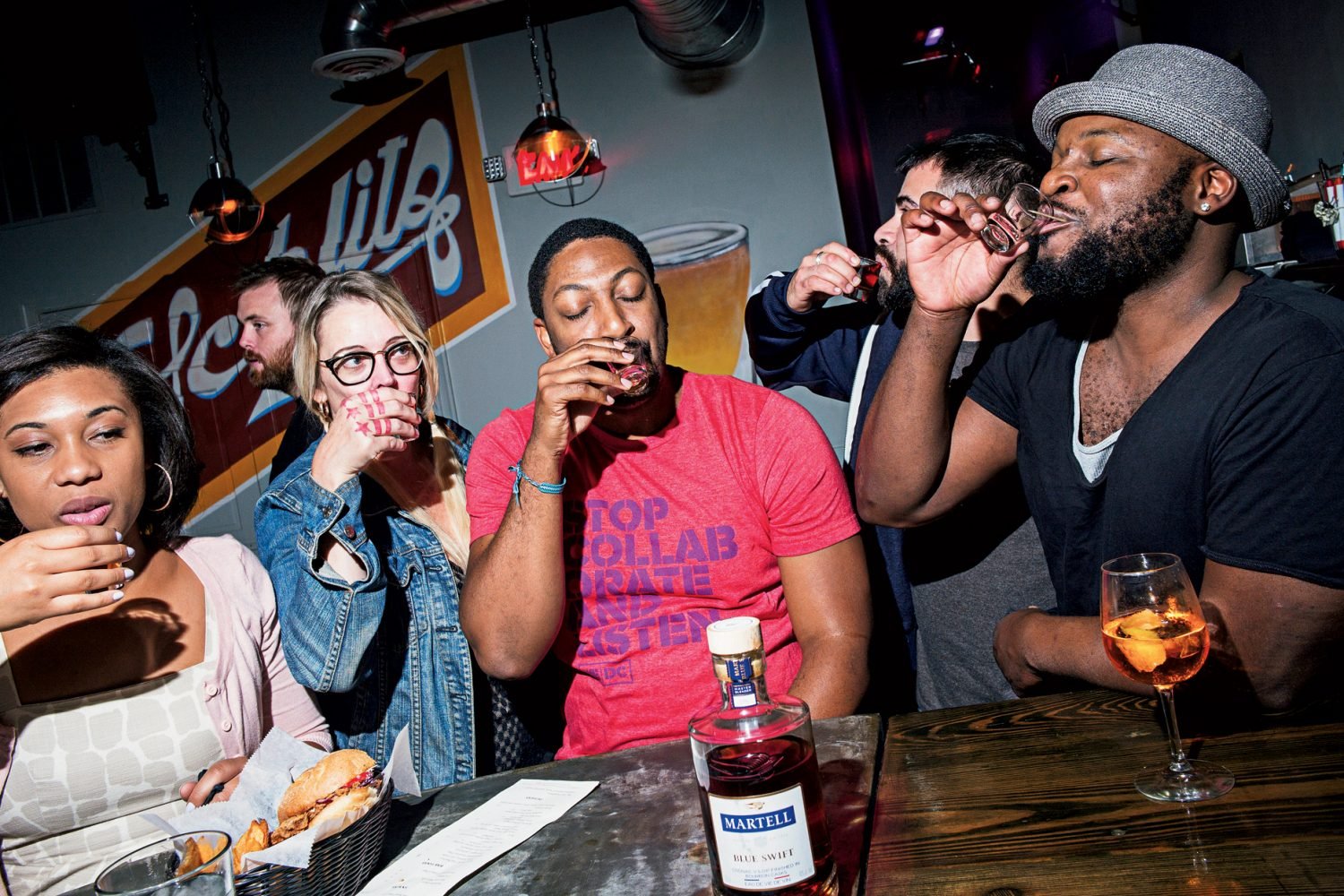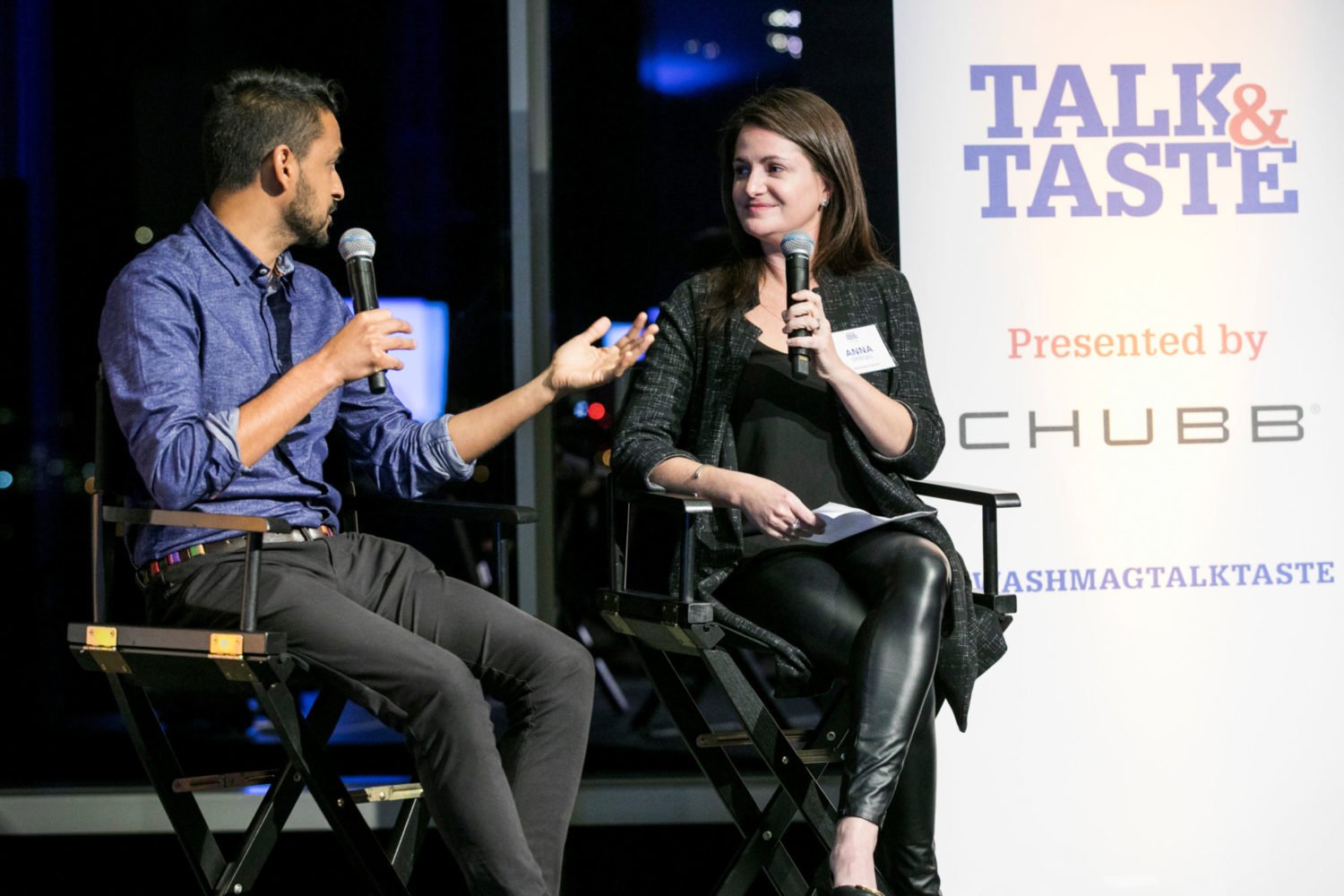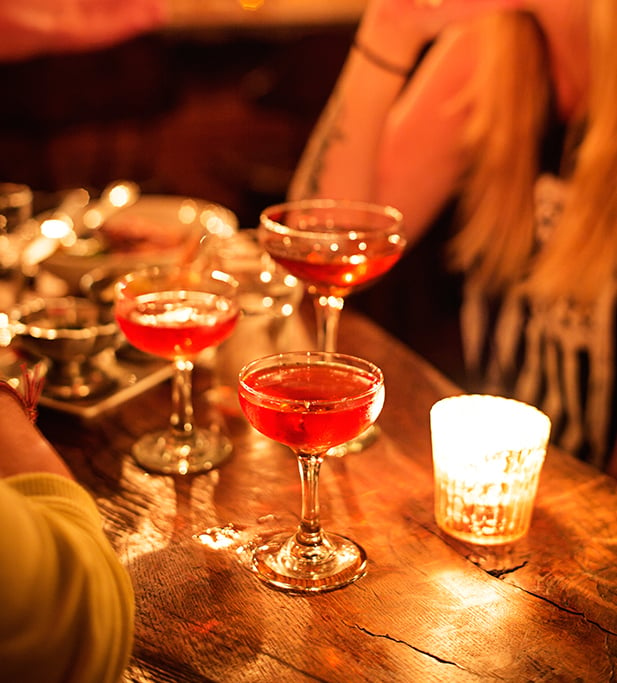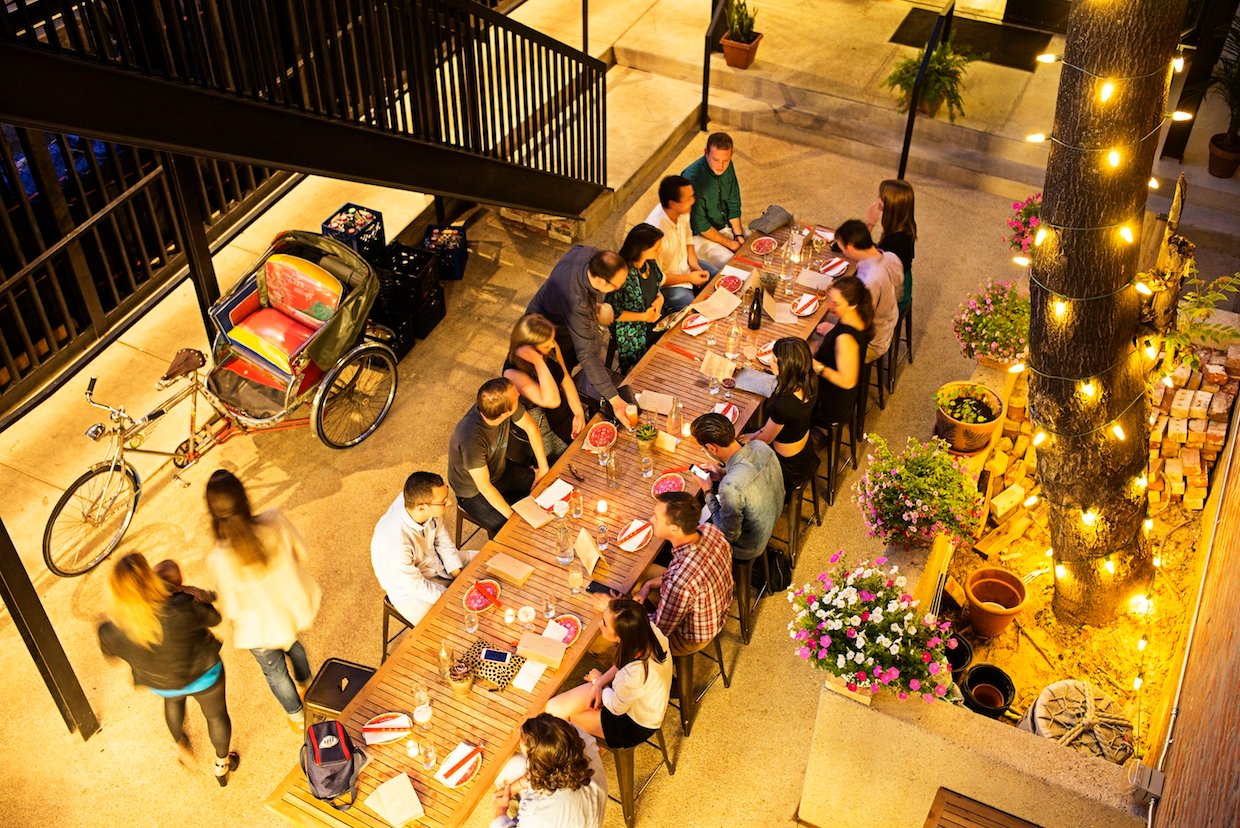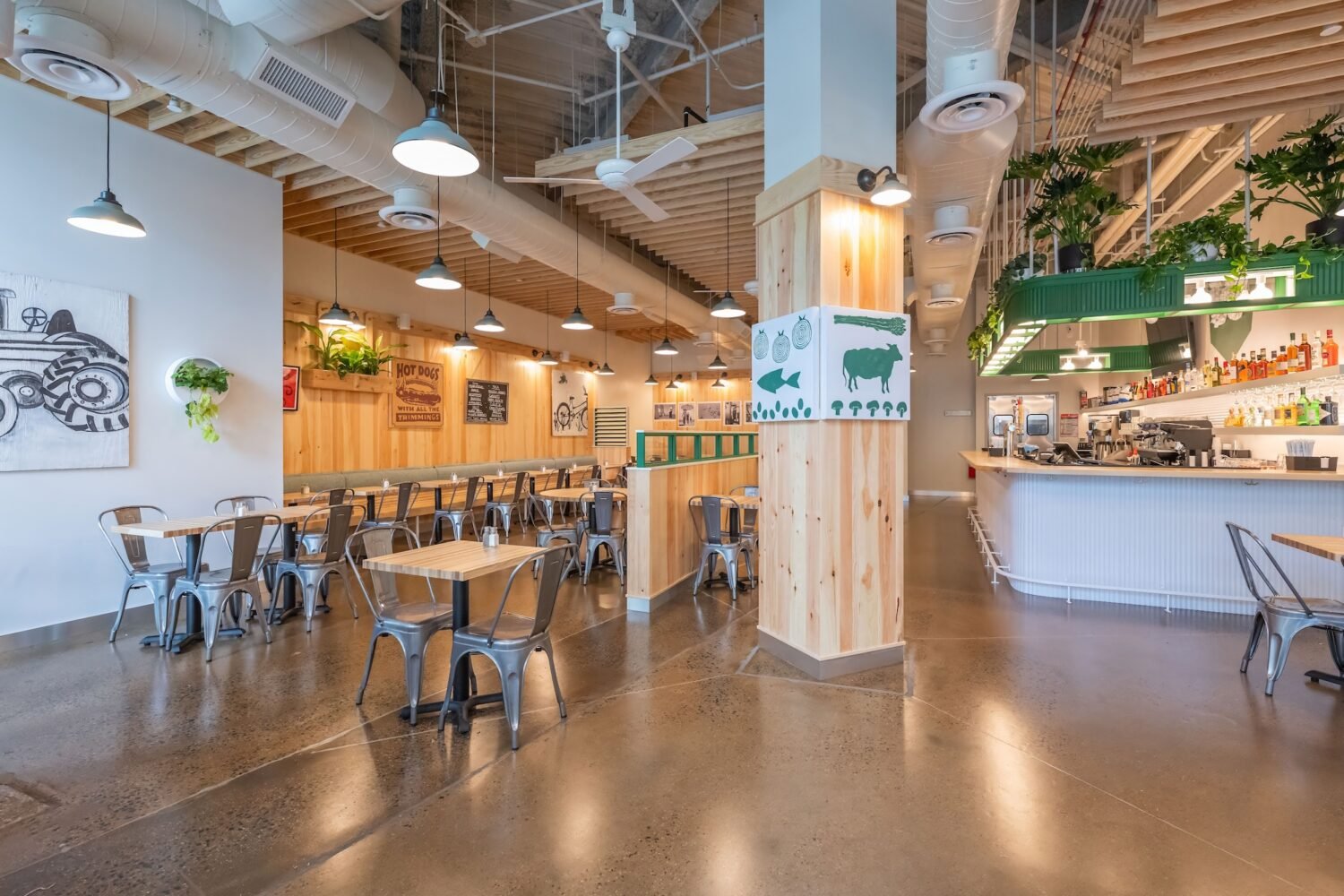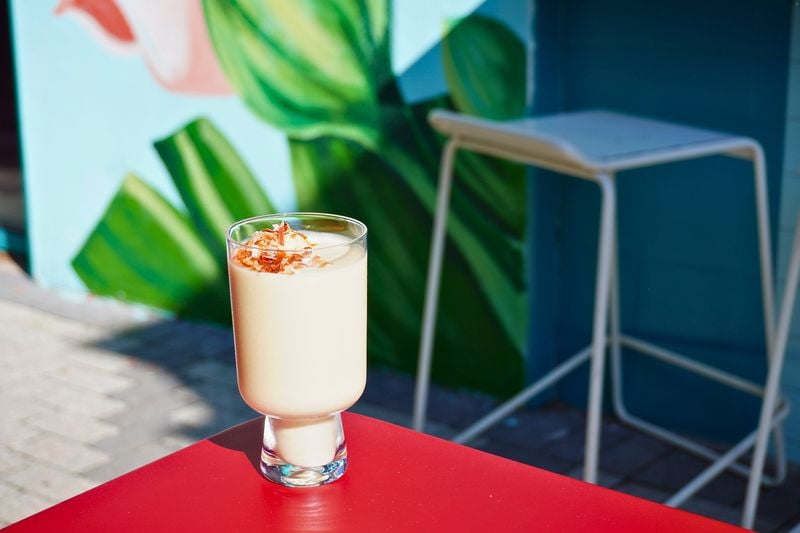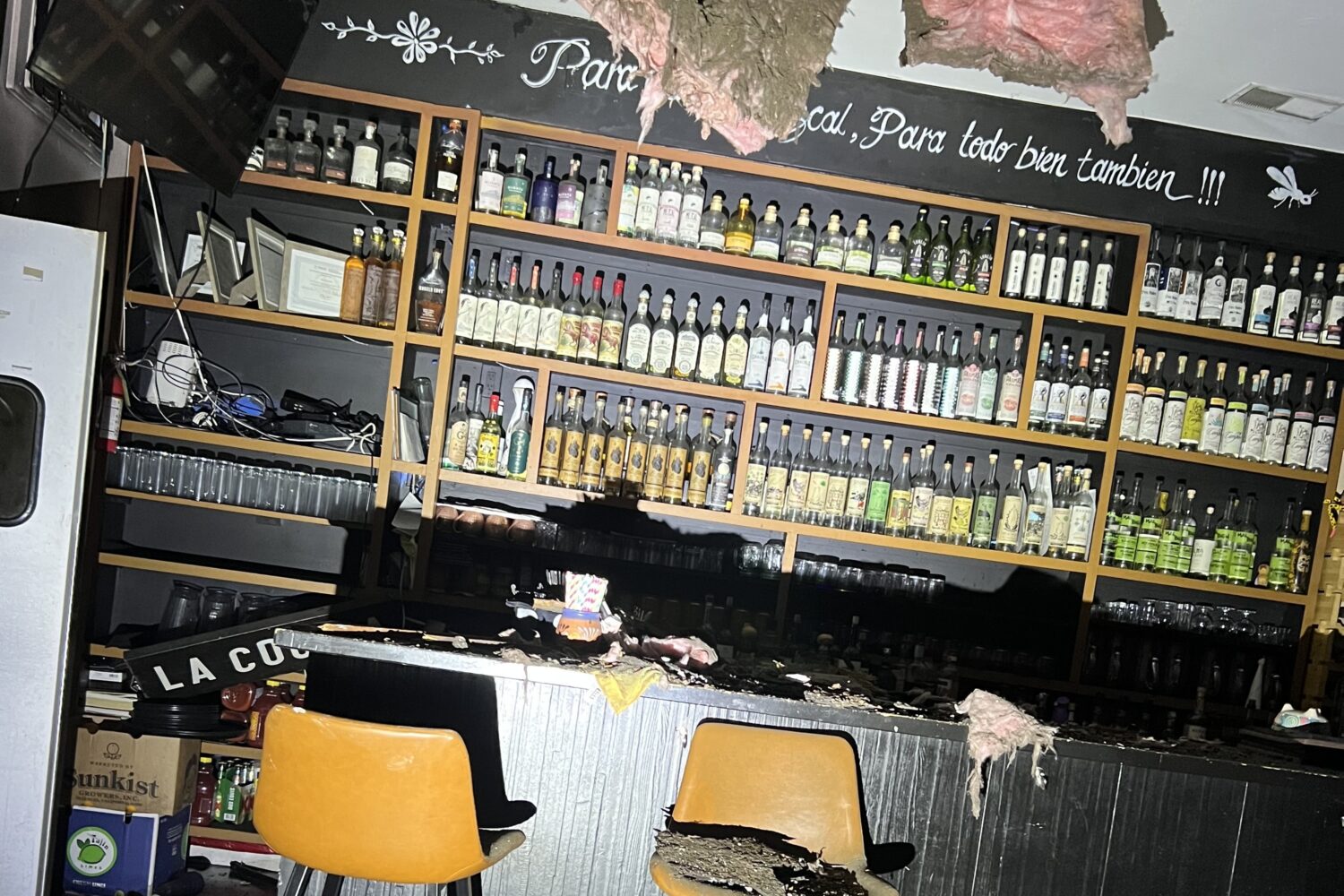
When the magazine with the buff dude showing off his six-pack on the cover every month called up and said, We want to fly you down to Mexico City to eat tacos, I didn’t envision having a Benito, or all that having a Benito entailed.
Benito was my butler for the week. When I met him at the airport, he had not only a sign with my name on it, but also lemon-scented towels and a bottle of mineral water.
“Welcome to Mexico City,” he said in stilted, heavily accented English. He wore a starched black jacket with gold buttons down the front and a solicitous smile that seemed only to emphasize a certain sadness.
I’d arrived more than two hours late because of a delayed connecting flight, and then it was another hour through traffic-clogged streets to my hotel. By the time I dropped my bags in my room, it had been nine hours since I’d downed a quick sandwich at the Houston airport. I was ravenous and light-headed, and all I could think about as I hustled down the winding staircase that smelled of club-goers’ cologne was running to the nearest taco stand.
But apparently, I would not be running alone. I wouldn’t even be running.
Standing at the door of the lobby, barring my exit, was Benito. And there was my driver, too, waiting at the curb, his car door open.
I said I thought this was maybe just the tiniest bit unnecessary, given that I was only going out to a taco stand.
No no, Benito said, with the gravest of expressions.
Benito had a nervous, deferential manner that made me nervous and deferential toward him, which in turn made him more nervous and more deferential. I could already see what kind of week it was going to be.
***
A week before I left, my editor had overruled my first choice of hotel as not expensive enough, and upgraded me to a new boutique property in a trendy neighborhood with 24-hour concierge, car service and, as it turned out, a Benito on call.
“We want you back in one piece,” he said, reminding me that I would be journeying to a land of carjackings, robberies, and kidnappings. Bon voyage and bon appetit!
I had never been to Mexico City, but I had read about it, and in the two weeks before I left I read more and more about it. If you’re looking to be scared about something, the internet is great for confirming your worst fears, as anyone who has ever searched for information on an ailment knows — everything from that little bump on your leg to that indigestion that won’t go away is potentially cancer.
I read about buses that had been stopped at gunpoint on the way to the Aztecan pyramids in Teotihuacan and robbed. I read about express kidnapping, in which victims are taken around to one ATM after another, forced to withdraw small amounts of cash at each to avoid systemic detection, until the account is drained, at which point they either are thrown from the car or killed. I read about the okay taxis and the not-to-be trusted taxis. I read the solemn and exhaustive report from the State Department to Americans traveling to the city, a document that kept me up late one night, imagining all the terrible, horrible things that might befall me.
The good thing about imagining the worst, of course, is that the worst never comes to pass. I was fine, as it turned out. The city worked on me in other ways. Got in my head, got in my bloodstream, altered my system, made me feverish, made me agitated, made me sick, made me walk around in a haze.
***
Every major city is a little like other major cities, and Mexico City is a little like New York in its frenetic pace, and a little like Los Angeles in its sprawl and traffic, and a little like Tel Aviv in its faded ’60s architecture, and a little like Miami in its color and pulse.
At the same time, it is nothing like those cities. And the ways in which it is not the same are a lot more interesting than the ways in which it is.
Picture it from the vantage point of an airplane window: a city perched 10,000 feet above sea level, situated on what was, long ago, a lake, belted in on all sides by mountains and volcanoes. The effect is of a cavernous bowl sunk down into the earth, atop which a thick perma-cloud of smog rests like the top layer of cheese on a French onion soup. Beneath it, the city boils away: 21 million people living, working, playing, coupling, killing, creating, oppressing, thriving, eating, sleeping, starving.
Pujol chef Enrique Olvera, who also commands the kitchen at the modern Mexican restaurant Cosme in New York, told the New York Times last month, “Mexico City is like a wave; you need to surf it. You don’t make plans, you just move.”
I longed to surf it. I longed to be able to walk out into the city, alone, and just move. That meant wandering the streets and getting myself lost. That meant ditching Benito.
***
I called Martin. If I was going to risk venturing into the city without my buffer who had vowed to do anything for me, I should at least have a warm body by my side.
Until the day he picked me up in his 4×4 to take me out to the pyramids at Teotihuacan, forty-five minutes northeast of downtown, Martin and I had never met. A friend of a friend of a friend had introduced me by email, and Martin, understanding that I had traveled to a city of 21 million where I knew not a single person, took it upon himself to look after me — to be part tour guide, part culinary explainer, and part (the part he loved) demonic Virgil.
Hurtling toward Teotihuacan, we discovered that we had been born within a month of one another, that our fathers were both brilliant, difficult men, that we shared a mutual love of Negronis, and that we both subscribed to the principle that if the night was good, then you stayed out late and made it great (and if the night was bad, then you stayed out late to make it good). The bond had been established, and with it the conditions for exactly the night of excess that came to pass.
We began our tour of Teotihuacan in the museum, taking in the burial plots of the ancients, the skeletons lit with an eerie light, glowing like coals, then began the ascent toward the Pyramid of the Sun, a perilous trek up 248 narrow, often uneven steps. Halfway there, my heart began to pound. I could feel it in my chest, and by the time we reached the top I was wheezing.

The view was majestic, and it was humbling to think of the civilization that was, of the city below that had once thrived. At the time of the arrival of Cortes and his men, the conquest that would lay waste to a people and culture and transform the place from a Nahuatl culture to a Spanish culture, the city was one of the largest in the world, larger than Paris and London. Down below us, I could hear the hawkers sounding the jaguar whistles they sold as souvenirs — a strange and primal sound, like that of wind whipping through a tunnel, only with more hint of animal danger, a sound that emphasized the feeling of being on the very edge of a society.
Which was so very apt, given that I was at that very moment struggling to breathe. It was as if some unseen hand were goring me between my eyes, not unlike the feeling you get when you guzzle a Slurpee too fast, only fifty times more intense.
If Benito were here, I thought, he would revive me, with a bottle of water and a cold cloth.
Or catch me if I fell.
But Benito was not here because I sneaked out of the hotel without Benito’s even knowing, a schoolboy cutting class.
Desperate to be out and about on my own, desperate to experience the city without a buffer. And now I was desperate.
The lonely, piercing sound of the whistle, the fact that I was gasping for air, the memory of all those stark and eerily lit skulls … for a moment, I had a vision of myself tumbling down from this perilous height, and I thought of Juan Escutia, the 19th century warrior who wrapped the Mexican flag around his body and leapt from the top of Chapultepec Castle—one of the six niños heroes who died defending the city from invading U.S. forces in the Mexican-American War, and the most resonant, perhaps because his death recalls that of another momentous descent from the sky—the great Aztec eagle, who, according to legend, swooped down from the sky to devour a snake on the swampy island of Texcoco and convinced the Aztecs to build their metropolis.
Falling, tumbling, descending …
It was not a religious experience I was having—there was no epiphany, no vision of the future, no moment, even, of clarity—but it was an experience all the same. Something was happening to me, in me. For a moment, I was not all there, or maybe I was all there, maybe I was more there than I ordinarily was, maybe I perceived and felt with a greater intensity, being so high, so woozy, so far from what I knew, so far from home.
And all this without even a drop of alcohol. I had yet to take my first sip of mezcal. I was under another influence as I stood there at the top of the Pyramid of the Sun. I had Roberto Bolano’s Savage Detectives on my brain, which was one reason I was thinking in long, shifting sentences like those above.
I had begun reading the novel, set partly in 1970s Mexico City, on the plane and by the time I met Martin it had taken hold of me like a narcotic.
“I’ll be Arturo, you can be Ulises,” he said when he saw me that morning, speaking of the Quixote and Sancho Panza of Bolano’s mock epic.
I felt pretty sure that whatever I saw, I was seeing through a Bolano filter, I was seeing the city through his depiction—a city of irrepressible vitality, of endless incident and color, of danger and violence lurking around every corner. The Savage Detectives doesn’t touch on the pre-Hispanic age of Mexico City, and yet it was hard not to think that Bolano’s ragged energies and panoramic vision were in some way informed by this history, by all that the city had suffered and assimilated.
“You okay?” Martin asked, searching my eyes.
I had gone somewhere, clearly.
As we descended, my breathing returned to normal, and with it the feeling that I had come out on the other side of something difficult.
Martin, looking to capitalize on my euphoria, suggested that it was time for drinks.
I consulted my phone; it was a little after 2.
“And tacos, of course,” he said.
***
Our destination was Taqueria Gonzalez, back in the city, not far from the San Juan market. The market has many adherents, among them chef Rick Bayless, for whom the sight of young rabbits shorn of their fur except for a tufted patch approaching the feet must be roughly equivalent to that of a penitent Catholic gazing upon the vault of a cathedral.
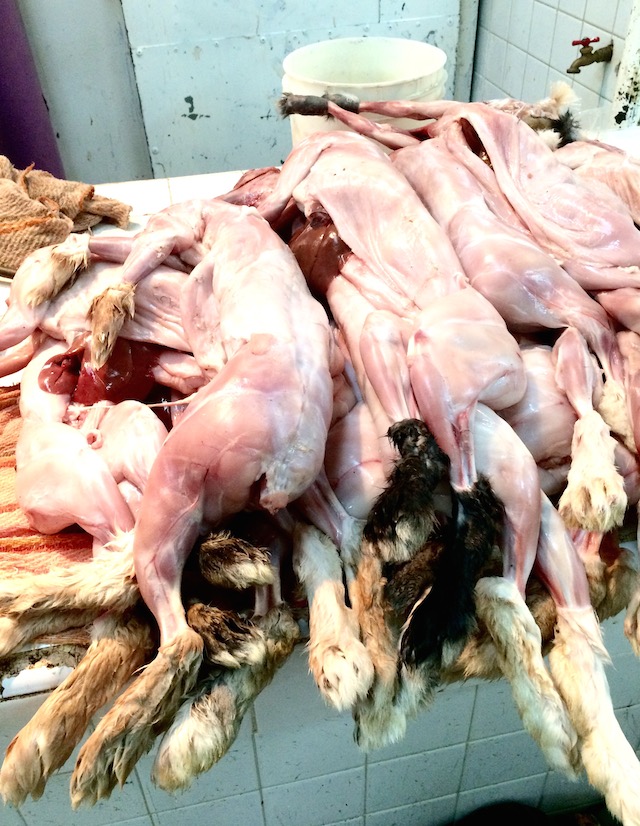
I knew the taqueria was going to be great when we walked up to it to discover both men in suits and men in sweaty t-shirts, both tourists and locals.
This was not a sit-and-eat operation, it was a stand-and-gorge operation. The focus of everyone’s attention was the great concave griddle, or comal, in the corner, a teeming mess of rajas, cubed potatoes, longaniza, and chopped pork of uncertain and possibly dubious provenance. A squat man working with the speed and efficiency of a short-order cook heaped massive quantities of meat and potatoes on my palm-sized tortilla, which I doused with guacamole. It was gloriously sloppy. We returned for seconds.
Martin thought it was good more than great, which is the sort of discernment you’re lucky to be able to indulge in when you live in a culture with tacos at every turn.
No, they were not at the level of the tacos I had had the night before, at a wonderful Oaxacan restaurant called Yuban. And the tacos at Yuban were not at the level of the tacos I would have later that night at Quintonil, honored by San Pellegrino as one of the 50 best restaurants in the world, where, at my waiter’s prompting, I converted a gorgeous hunk of wagyu chuck draped with a chili demiglace into three small tacos, embellishing them with an ink-black swipe of sauce made of huitlacoche.
But I came from the land of store-bought, mass-produced tortillas with crummy fillings and weak salsas, which was why I was so sorely tempted to wrap the squat man at the comal in a great big bear hug.
***
“I don’t want to pull you off assignment,” Martin said (meaning he did), “but you can’t come to Mexico City without visiting at least one pulqueria.”
I’d done my homework. I knew what pulque was, the fermented sap of the agave plant, a drink the Aztecs deemed the “drink of the gods.” But knowing something on paper is not the same as knowing something tangibly—the difference, the crucial difference, between book learning and experience. Las Duelistas was like nothing my reading had prepared me for, hot and moist like a sauna, crammed tight with sweating patrons of varying ages, intricate colorful art covering nearly every inch of the space, including the ceiling, which bore, like a Renaissance cathedral, an image of a God.
Martin had been here before, and suggested going with the degustacion, a tasting flight consisting of five samples of pulque of varying colors, red, green, orange, light yellow, and pearlescent. The least appealing was the pearlescent, which Martin informed me was pulque in its natural state, unadorned, without flavoring.
“This is the one we start with,” he said, “and work our way up.”
I peered into the glass. It didn’t look promising.
“A little salty, a little bitter, a little viscous,” Martin offered.
I reached for the glass.
As I took my first taste, he said, “I’ve been told it tastes like semen.”
“Thanks,” I said, setting the glass down.
“No problem.”
The pulque got better, much better. But of course it had only up to go.
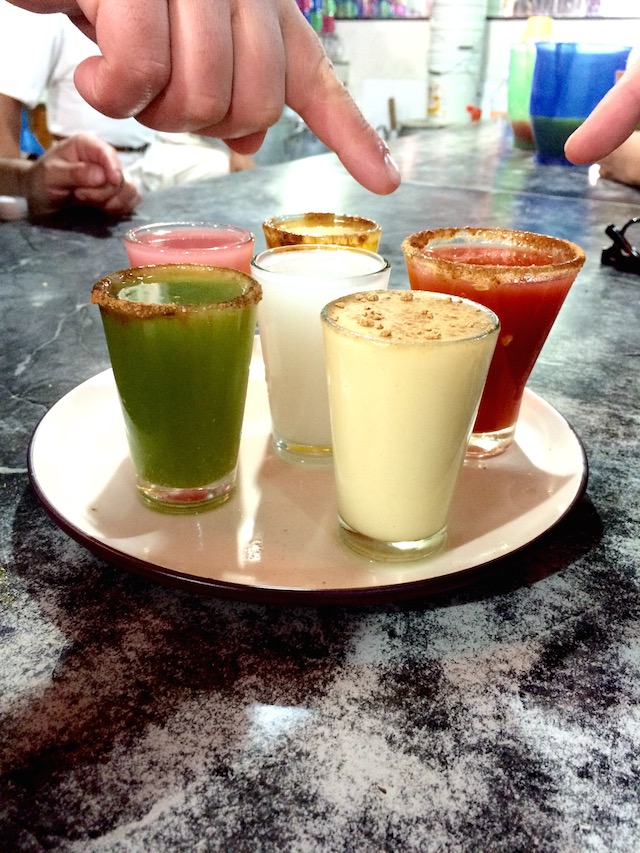
From there we moved to beer, and then from beer to mezcal. By dinner time, I had slipped into a haze and was grateful that Benito had appeared by my side, to guide me to dinner.
***
In The Savage Detectives, the aging poet Amadeo Salvatierra, one of the novel’s 52 narrators, keeps reaching for his bottle of mezcal as he recounts his memories of the bohemian poets Arturo and Ulises. The brand, Los Suicidas, is no longer in existence, he notes, and in lamenting its passage he laments the passage of time.
At dinner I ordered a glass of Alipus, whose bottle features at a stark, black-and-white woodcut of a warrior on a horse, looking down at a poor, harrowed soul on the ground. The poor, harrowed soul has his hand up, begging surrender. In my reading of the image, the warrior is mezcal, the poor, harrowed soul the unsuspecting drinker: No more mezcal! No more assault!

My rationalization for more mezcal was that its smoky bite made for an ideal pairing with the food, and that I was here, after all, to learn about the culture, which only goes to show that when you want to you can rationalize anything.
Meeting up with Martin later (he had had the good bourgeois sense to return home to his wife and four children for dinner before giving in to his bohemian impulses), I had no more excuses. I was simply indulging.
Our first stop of the night—at the time, I had thought it was to be both our first and also our last stop—was a “mixological speakeasy” hidden beneath an unassuming cantina in his neighborhood, the trendy, restaurant-laden Polanco. I was interested, was I not, in knowing what a mezcal Negroni was like?
The unsmiling linebacker barring our entrance didn’t care about my research needs as decided by my new best friend Martin. We were not dressed all in black. We were not in our 20s. But Martin strode right up to him and, in the manner I imagined he had perfected years earlier in the courtroom, addressed the stern judge with all the charm, confidence, and certitude he could muster.
The judge listened without appearing to and relented, waving us in without so much as looking at us.
“What’d you say?” I asked Martin, as we descended into mezcal hell.
“That you were a figure muy importante en los Estatos Unidos.”
The mezcal Negroni went down like punch, as did the mezcal cocktail in the place we went after, a small bar several blocks away, where my research needs took us.
Liquid fire, dressed up to look like innocent refreshments.
***
I woke up in the middle of the night, heart racing, mouth parched. When I went to get a drink of water, I was so light-headed that I had to brace myself against the furniture in the room.
The next morning did not exist. I did not wake up for it. I wanted to not wake up for the afternoon, too, but I was not so lucky.
Martin texted to inquire how I was doing “the day after.”
I was not doing. I did not want to do.
I ticked off my symptoms.
Sounds like altitude sickness, he wrote back, and advised me to go to a pharmacy and buy a box of Dorixina Relax, a muscle relaxer. The otherwise simple act of walking to the store sounded, now, like a massive effort of will, and I knew that I could not just slip off to the pharmacy, that Benito would be shadowing me. Maybe a nap would help. Maybe I would wake up and all of this would just go away.
But when I woke up two hours later, it had not gone away, it was just as bad as before.
No, I thought, getting out of bed, it was not just as bad, it was worse. I put pressure on my foot, and the throb went zoom!—all the way to my head. Yes, I thought, it was unequivocally worse. I was torn between wanting to go back to bed and vomit.
The last thing I wanted to do, the very last thing, was go to lunch, but being a professional means playing hurt, playing through pain. I got dressed and went downstairs, clutching for the railing that wasn’t there as I descended the narrow, winding steps.
Waiting for me in the lobby was Benito. I nodded. He bowed.
Whether we had now passed to the phase of making awkward conversation in our broken versions of each other’s language, or whether he had simply taken my measure and decided to be upbeat, I wasn’t sure, but as we walked outside to the waiting car Benito said, “How are you in love with Mexico City?”
I lay limp against the backseat, feeling as lively as those mounds of bones we had seen at Teotihuacan. They, at least, glowed like coals. No amount of production value, I knew, was going to revive me. My skin was flushed. No, it was cool. No, it definitely was flushed. I reached for the cool, lemon-scented towel, hoping for refreshment. Uh uh: too cold. I rolled up the window. I began to sweat.
Hurtling toward the restaurant, I wondered if Los Suicidas had been rebranded as Alipus.
***
Midway through lunch, Benito came in to check on me. I asked for an aspirin, desperate to ease the pounding. The pill arrived ten minutes on a small saucer, like a mid-meal palate cleanser.
Benito, from the Latin: blessed.
After the meal, he smiled and bowed when I slipped him 100 pesos and asked where I would like to go next, prepared, no doubt, for another multi-stop adventure: a trip to a taqueria, followed by a pit stop at a taco stand, followed by a coffee refueling, and then maybe a trip to another taqueria.
“Farmacia,” I said weakly.
In the States, you need a doctor’s prescription for a muscle relaxer. In Mexico City, only a valid form of ID, and some reassuring words from a Benito.
Take one and call me in the morning, Martin texted.
Host, chaperone, culinary advisor, tour guide, and now doctor, too.
I had plans to meet my friend Ines, the editor of the magazine El Gourmet, for dinner later that night at a restaurant she was high on (“they have very good insects,” she wrote via email the week before). I set my alarm for three hours and popped the pill.
I had also picked up altitude pills at the farmacia. I popped those, too.
It was six o’clock. I never did hear the alarm. I woke up the next day at 8, 14 hours later. The last time I had slept 14 consecutive hours was — no; there was no last time; I had never slept 14 consecutive hours.
What the hell was in this stuff?
Martin drugged me, was all I could think.
First he drugged me with mezcal. Now he has drugged me with strange pills.
This was what I needed Benito for; not to save me from kidnappers. To save me from Martin.
I texted Inés my apologies, citing the mezcal hangover and my altitude sickness.
Is this your first time drinking a lot of mezcal? she wrote back. Welcome to Mexico City. 🙂
***
A walk in the park—the Parque de Mexico was cattycorner from my hotel—was still not a walk in the park: I could manage only a few hundred yards at a brisk pace the next morning before becoming winded. But the hangover had lifted. The nausea was no longer a constant but came and went in waves. Improvement: I would take it.
The lingering effect of the Dorixina, however, was to make me feel as if I had been wakened prematurely from an anesthesic slumber, while the pitiless city whipped by me in a blur.
Martin picked me up and we drove down to the village of Coyoacan, south of downtown, to meet with Alejandro Escalante, a taco scholar who owns a restaurant, La Casa de Los Tacos, not far from the electrically colorful house where Diego Rivera and Frida Kahlo lived.
Before I arrived in Mexico City, I had thought that the taco was roughly equivalent there to the burger in a city like New York. Both street foods, both highly democratic in their appeal.
But the taco penetrates life in Mexico City in a way the burger, for all its popularity, never has or will. I saw tacos at the large, centralized markets and tacos at the temporary markets, called tiangis, tacos at street stands, tacos at corner stands, and tacos on bikes — sold by kids pedaling through neighborhoods. I saw tacos at every rung of the gastronomic ladder, with chefs taking the humble snack to new levels of refinement. I ate tacos for breakfast and lunch and dinner. I ate tacos between meals, on the way to more tacos. I ate rolled tacos and fried tacos. I ate flat tacos, called tlacoyos, and folded tacos. I ate tacos sudados, sweaty tacos, tacos stored in covered woven baskets and allowed to steam.
It hardly seemed possible, but every taco I had tasted so far had been better than the last, and at each stop I had been forced to recant my prior declaration that I had found the best taco in the city of tacos. But now, at Escalante’s, I came to tacos pechito, beef breast tacos, the rich, tallegio-soft meat slipped inside corn tortillas pulled hot off the comal behind us. These were tacos so vivid and intense that it was as if I were eating something other than tacos.
Was this the effect of the Dorixina?
To simultaneously slow me down and heighten my senses?
Or was this simply what Mexico City did to people, seeped into their system and made them vulnerable to stimuli, overpowered them with sensation?
My appetite was coming back, though how cruel that my nausea should be at high tide when I sat down to lunch at a pillar of contemporary Mexican gastronomy but ebb just in time for me to sample the wide world of insects.
I had eaten grasshoppers before, more than once, but grasshoppers are generally regarded as the gateway critter in the world of pre-Hispanic cuisine, as easy and accessible.
With Escalante looking on, a waitress brought us what her boss described as one of the great delicacies of “pre-Hispanic cuisine”—an oblong dish containing hundreds of tiny corn kernels, called escamoles, which had been tossed with onion, garlic, cilantro, and epazote, a minty herb used in stews, soups and beans.
Just how pre- were we talking about? I wondered silently.
Plucking one of the mystery kernels between his thumb and forefinger, Escalante said, “These are not just any ant eggs.”
“No?”
“No no,” he said, and locked eyes with me, making certain I understood the seriousness of what he was saying. These were carefully sourced eggs, he said, the eggs of soldier ants.
I was still in the zone of slowness and heightened clarity.
Ant eggs.
Would-be ants.
Ant babies.
They looked like little pills.
I took them into my mouth. Tender, delicate. Rich. A little nutty.
I made a taco. I took a bite. Another taco that didn’t taste like a taco, with flavors for which I had no point of comparison, for which there was no personal precedent.
***
Of all the insect-eating countries in the world, I learned from Inés when we finally connected, Mexico is at the top, with 504 of what she called “known edible species.”
She was proud of this standing, lamenting that food globalization has made beef and chicken king and “displaced” the “wide spectrum of possibilities that insects have to offer.”
Possibilities. Inés had come prepared; she was determined to plead her case for their worth and importance and open my mind.
Was I aware that a hundred grams of crickets have more protein than a hundred grams of beef?
My eyes widened.
Did I know that insects are organic? That they are good for the environment? That they are both seasonal and local?
We could have been talking about four-dollar tomatoes at the farmers market.
Her great hope, she said, is that as a new crop of Mexican chefs revives interest in insects as it seeks to reclaim its terroir, in much the same way Southern chefs like Sean Brock and others have with benne seeds and heirloom varieties of pork, it will “bring in others to look into the variety of products in the markets and restore the traditional Mexican diet, which is by far more diverse, healthy, nutritious, and tasty than what supermarkets offer. Just like Louis XVI did with potatoes in France.”
She had one last thought for me, one last attempt to sway me and bring me into the fold.
“Just the thought of entomophagy repels some,” she said, “but we define what we eat by what we’ve learned to think about it.”
***
Nick Gilman, who writes the blog Good Food in Mexico City, had urged me to speak with a man named Juan Pablo Ballesteros, owner of a restaurant called Limosneros. On my last night in the city, I went to meet him.
It was raining, a hard drizzle that glazed the streets and rendered the old, colonial-era buildings heavy and forlorn. Benito and my driver waited for me in the car, like movie mobsters.
A tall, strapping guy with tight, curly hair and the impish expression of Georges Perec, Ballesteros is descended from taco-making royalty. More than a hundred years ago, his grandfather opened a restaurant called Cafe Tacuba, in the city’s historic center. The place is still standing, a beloved relic of the scene. Limosneros, with its chandeliers, handsome wood tables, and dark mood lighting, doesn’t just extend the family line; it attempts to extend the possibilities for the contemporary taqueria.
Ballesteros let me order a few dishes on my own, then began sending out treats. The first dish was tuna tacos garnished with citrus foam. Light, trendy, the sort of thing you can find in the States at most upscale Mexican restaurants and, as it turned out, a sly bit of misdirection, because this was not what Pablo was here to show me. Out came a superior mezcal, served in a thin, carved cup that nestled perfectly in my palms, along with a bowl of ant eggs and a basket of fresh tortillas.
“You eat insects, right?” Ballesteros asked, with only the faintest trace of a question in his voice.
Because he was not asking—he was confirming. Of course I ate insects, right? As a food writer, a professional eater of food, I of course did not presume that I could hope to understand the culinary culture of Mexico City and not eat insects, did I?
He smiled as he watched me spoon the ant caviar onto the tortillas.
The next plate was among the most gorgeous of my trip, vibrantly colored, harmoniously arranged, the sort of intricate culinary artwork that tasting menus exist to display. Even in the low-lit room it was impossible to miss how dazzling an arrangement this was, but I sat forward, now, to get a better look it: four squash-blossom canapes set off dramatically by thick dabs of orange and green sauces and garnished with what appeared to be pieces of fried meat.
“Beetles,” said Ballesteros.

He eyed me carefully, gauging my reaction. It was no doubt the readiness with which I had taken to the tiny white eggs that had persuaded him that I was prepared to graduate to the next level.
Ant eggs, at least, resembled tiny corn kernels. There was no mistaking what this was. My first thought was that my beautiful plate of food had been infested by a small army of bugs. My second thought was: I can’t. Followed immediately by my complicating third thought: I can’t not. With him standing right there, eager and proud? And call myself a food writer? And not feel like a hypocrite for espousing adventurousness and open-mindedness?
I lifted the nigiri-like pad and tilted it slightly toward a dab of sauce, as if I were about to eat a bite of yellowtail. The bug fell off, and I jumped.
Enough dallying.
I picked up another pad, exhaled a deep breath, and ingested the thing all in one bite.
I immediately sought precedent in my data bank of food memories. None came.
Well, wait, no. A sort of meaty toastiness, like a pecan that had been roasted for forty minutes.
Literally, though, this was a taste of the earth, much more than any plant that has been lifted up through the soil. I was sitting in a trendy restaurant that plates its dishes to resemble works of art, and I was eating a bug that took me back to the roots of the city, before it was a city, before the Spanish arrived to lay waste to it and construct a new culture in its place. The place now was not the place then. Its grid was that of a European city. Its people were of mixed identity, and spoke Spanish. A new culture had evolved. The bugs, though, remained. They hadn’t been snuffed out. To eat them was to reach back at least 500 years and taste the earthy essence of that vanished time.
Limosneros had done what most museum curators aimed to do with their exhibits: to present the past in a way that was accessible, modern, and above all interactive. My meal was nothing if not interactive. I did not learn about that past. I ingested that past.
I got up from the table, feeling woozy. No, it wasn’t wooziness. I was definitely ill again.
This, too, felt right, even if it felt wrong. I would struggle to digest what I thought I had learned. The hard, intense place was showing me once more that it was harder and more intense than I had reckoned with.
I walked outside. The rain had dissipated to a drizzle. Benito regarded me with a smile I didn’t understand, a quizzical smile that mingled deep concern and amusement. Or maybe he was just trying to understand me, something that even after a week in my company had eluded him.
“Come,” he said.
Blessed Benito.
He took me by the shoulder with the tender guidance of a nurse and led me toward the waiting car.
“I will take you back,” he said.
***
The other book I brought with me to Mexico City was Down and Delirious in Mexico City, by Daniel Hernandez, an exhilarating, sometimes frightening chronicle of a modern metropolis that feels at once familiar and strange.
At his best, Hernandez is as exuberant as Dickens writing about London and as observant as Balzac writing about Paris. His relentless drive, however, owes a debt to Hunter S. Thompson, with whom he also shares a fondness for visceral detail. In the very first paragraph, he takes the car from zero to sixty, and doesn’t ease up on the gas for the next 288 pages.
“Life in Mexico City,” Hernandez writes, “is a contact sport. It might be scary at first, unforgiving, violent, but to really grasp it, you gotta get in, release all inhibitions, all cultural blinders. You have to get down and play.”
I reached out to him when I returned home, and he confessed to worrying that the city’s “intensity maybe sometimes ventures toward becoming second-nature. I bet it is for a lot of people who were born and raised and continue living here.”
And as for Hernandez?
“I just usually need a little visit to the serenity of the strip malls and highway interchanges of the United States,” he wrote, “to remind me that where I live is a beautiful lake of fire and I should be thankful everyday that it doesn’t eat me up. … The daily barrage of wonders and averted disasters transforms you.”

